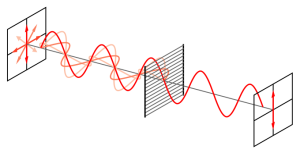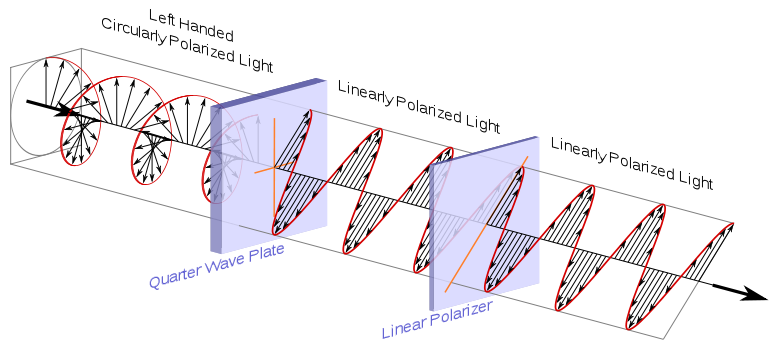Linearly polarized glasses
To present a stereoscopic motion picture, two images are projected superimposed onto the same screen through orthogonal polarizing filters (Usually at 45 and 135 degrees). The viewer wears linearly polarized eyeglasses which also contain a pair of orthogonal polarizing filters oriented the same as the projector. As each filter only passes light which is similarly polarized and blocks the orthogonally polarized light, each eye only sees one of the projected images, and the 3D effect is achieved. Linearly polarized glasses require the viewer to keep his or her head level, as tilting of the viewing filters will cause the images of the left and right channels to bleed over to the opposite channel. This can make prolonged viewing uncomfortable as head movement is limited to maintain the 3D effect.

Circularly polarized glasses
To present a stereoscopic motion picture, two images are projected superimposed onto the same screen through circular polarizing filters of opposite handedness. The viewer wears eyeglasses which contain a pair of analyzing filters (circular polarizers mounted in reverse) of opposite handedness. Light that is left-circularly polarized is blocked by the right-handed analyzer, while right-circularly polarized light is extinguished by the left-handed analyzer. The result is similar to that of steroscopic viewing using linearly polarized glasses, except the viewer can tilt his or her head and still maintain left/right separation (although stereoscopic image fusion will be lost due to the mismatch between the eye plane and the original camera plane).

Circular polarizer passing left-handed, counter-clockwise circularly polarized light
By rotating either the QWP or the LPF by 90 degrees about an axis perpendicular to its surface (i.e. parallel to the direction of propagation of the light wave), one may build an analyzing filter which blocks left-handed, rather than right-handed circularly polarized light. Interestingly, rotating both the QWP and the LPF by the same angle does not change the behaviour of the analyzing filter.